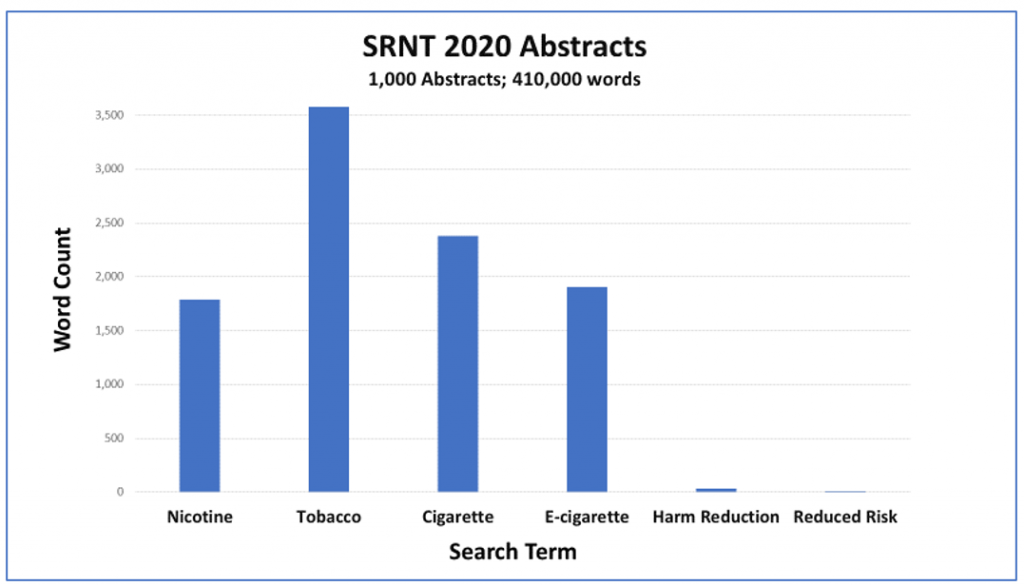The Society for Research on Nicotine and Tobacco (SRNT)’s annual meeting went ahead March 11–14, 2020, despite ominous COVID-19 clouds looming on the horizon. Over half of registered participants pulled out, including all speakers and participants from the US Centers for Disease Control and Prevention (CDC) and the US Food and Drug Administration (FDA). But we can still explore the abstracts from speakers and poster presentations, to find out just how much words really do count.
SNRT 2020 accepted over 1,000 abstracts that averaged just over 400 words each. Out of an approximately 410,000 collective word count, let’s look at the frequency of key terms and consider what this says about the direction of the latest nicotine and tobacco research in the United States (where most participants were from). For benchmarks, the word ‘nicotine’ occurs 1,788 times, and the word ‘tobacco’ occurs 3,577 times.
Does harm count?
What does this analysis say about the things that cause cancer, heart and lung disease? ‘Smoking’ shows up 3,178 times, and ‘cigarette’ 2,377. What about diseases that result from smoking combustible cigarettes? ‘Cancer’ gets 476 hits. ‘Cardiovascular disease’ shows up only 40 times, and the word ‘heart’ just 27. ‘Lung’ appears 137 times, but 56 of those instances refer to ‘lung cancer,’ so there were only 81 references to lung function unrelated to cancer.
Does harm reduction count?
‘Harm reduction’ appears only 32 times (in 17 out of 1,000 abstracts), and ‘THR’ (tobacco harm reduction) not at all. ‘Reduced risk’ is used just 11 times in 8 abstracts. So, only 1.7% of abstracts mention ‘harm reduction’, although this concept is part of ‘tobacco control’ under its official definition in the Framework Convention on Tobacco Control. ‘Reduced risk’ is mentioned in only 1.1% of abstracts.
What about lower harm products that help smokers quit? ‘E-cigarettes’ were mentioned 1,902 times (nearly as often as cigarettes). ‘ENDS’, or Electronic Nicotine Delivery System, appears 432 times, and ‘vaping’ 635. ‘Smokeless’, however, clocks in at 143 mentions; ‘snus’, only 31. ‘NRT’, or nicotine replacement therapy, gets just 123 hits. ‘Patch’ (as in nicotine patch) appears 48 times.
2019 saw an outbreak of vaping-related lung injuries. It is now evident that Vitamin E acetate, an adulterant used to cut THC (tetrahydrocannabinol) vape oils, was the primary (if not sole) cause of those injuries. ‘Vitamin E acetate’ is not mentioned in any SRNT 2020 abstract. THC, the psychoactive ingredient in cannabis, was mentioned only 61 times.
Do health benefits count?
Nicotine has intriguing potential health benefits that may include the prevention of Parkinson’s disease and treatment for people with Attention-deficit/hyperactivity disorder (ADHD). Among SRNT 2020 abstracts, ‘Parkinson’s disease’ is mentioned only once; ‘ADHD’, only 28 times.
Interpretation
What do these numbers tell us about SNRT 2020 nicotine and tobacco research trends? First, there’s a healthy focus on the thing that kills people: smoking. There is relatively little focus on diseases caused by smoking, but this is not surprising. Cancer will, presumably, be discussed in cancer meetings, cardiovascular disease in cardiovascular disease meetings, and so on.
Numerous abstracts mention e-cigarettes and vaping, but very few do so in the context of tobacco harm reduction. Most researchers studying these relatively new nicotine-delivery products seem focused on potential harm. For a professional society focusing on nicotine and tobacco research, the number of abstracts exploring potential health benefits of nicotine seems strangely low.
Time to demand a recount?
This was a simple exercise undertaken for illustrative purposes. An exhaustive review and categorization of all SRNT 2020 abstracts would take weeks and would ultimately still be somewhat subjective. The SRNT conference showcases the latest and greatest tobacco-related research. What concerns me is the priorities apparent in that research. There is an old saying: “If all you have is a hammer, everything looks like a nail.” The field could benefit from a full analysis of priorities implied by all research grants. That analysis could in turn point to potentially valuable, but currently neglected, avenues of research.

© 2023 Foundation for a Smoke-Free World. All rights reserved.